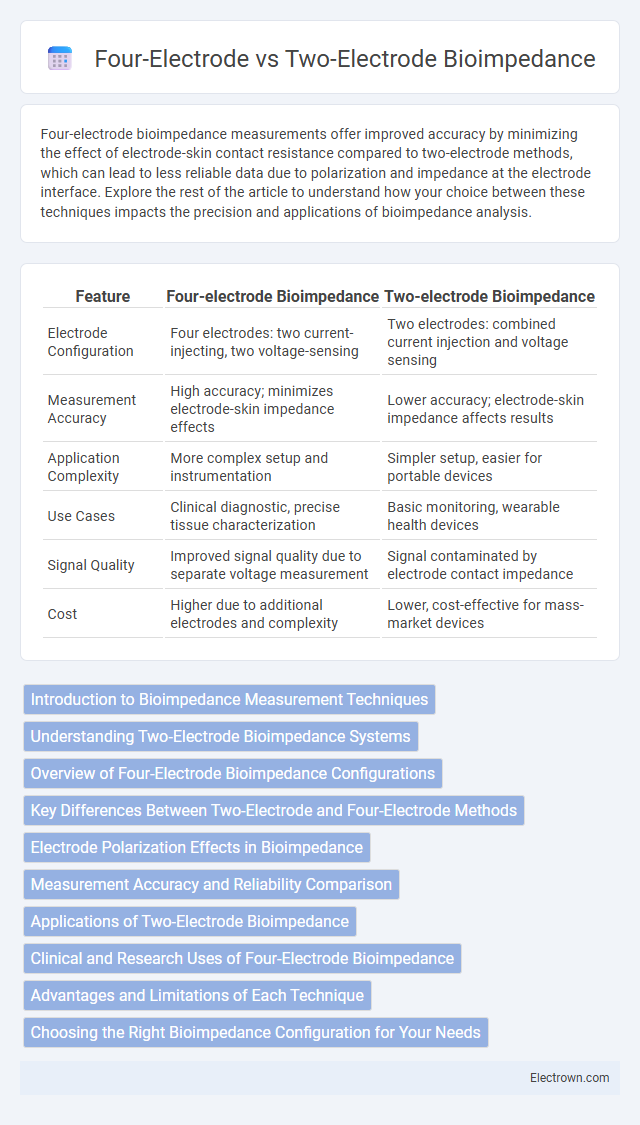Four-electrode bioimpedance measurements offer improved accuracy by minimizing the effect of electrode-skin contact resistance compared to two-electrode methods, which can lead to less reliable data due to polarization and impedance at the electrode interface. Explore the rest of the article to understand how your choice between these techniques impacts the precision and applications of bioimpedance analysis.
Table of Comparison
| Feature | Four-electrode Bioimpedance | Two-electrode Bioimpedance |
|---|---|---|
| Electrode Configuration | Four electrodes: two current-injecting, two voltage-sensing | Two electrodes: combined current injection and voltage sensing |
| Measurement Accuracy | High accuracy; minimizes electrode-skin impedance effects | Lower accuracy; electrode-skin impedance affects results |
| Application Complexity | More complex setup and instrumentation | Simpler setup, easier for portable devices |
| Use Cases | Clinical diagnostic, precise tissue characterization | Basic monitoring, wearable health devices |
| Signal Quality | Improved signal quality due to separate voltage measurement | Signal contaminated by electrode contact impedance |
| Cost | Higher due to additional electrodes and complexity | Lower, cost-effective for mass-market devices |
Introduction to Bioimpedance Measurement Techniques
Bioimpedance measurement techniques analyze the electrical properties of biological tissues by applying small currents and measuring voltage responses. Four-electrode methods use separate pairs of electrodes for current injection and voltage sensing, minimizing the effect of electrode-skin contact impedance for more accurate intracellular and extracellular fluid analysis. Two-electrode techniques combine current and voltage measurements through the same electrodes, offering simplicity but often sacrificing precision due to higher contact impedance influence.
Understanding Two-Electrode Bioimpedance Systems
Two-electrode bioimpedance systems use the same pair of electrodes for both current injection and voltage measurement, which can simplify hardware design but often leads to less accurate readings due to electrode polarization and contact impedance effects. In contrast, four-electrode bioimpedance systems separate current injection and voltage sensing electrodes, significantly reducing measurement errors caused by skin-electrode interface impedance. Understanding the limitations of two-electrode methods helps you assess their suitability for applications where cost and simplicity are prioritized over precision.
Overview of Four-Electrode Bioimpedance Configurations
Four-electrode bioimpedance configurations employ separate pairs of electrodes for current injection and voltage measurement, significantly reducing the influence of electrode-skin contact impedance on the accuracy of measurements. This setup enhances precision in assessing tissue properties by minimizing signal distortion caused by interface impedance. Widely used in clinical and research settings, four-electrode systems improve reliability and repeatability compared to two-electrode methods, especially in applications requiring detailed bioelectric characterization.
Key Differences Between Two-Electrode and Four-Electrode Methods
The key differences between two-electrode and four-electrode bioimpedance methods lie in measurement accuracy and electrode configuration. Two-electrode systems use the same pair of electrodes for current injection and voltage measurement, often leading to errors caused by electrode-skin impedance. In contrast, four-electrode methods separate the current-carrying and voltage-sensing electrodes, minimizing contact impedance effects and providing more precise bioimpedance readings for your clinical or research applications.
Electrode Polarization Effects in Bioimpedance
Electrode polarization effects significantly impact the accuracy of bioimpedance measurements, with four-electrode configurations reducing these distortions by separating current injection and voltage sensing electrodes. Two-electrode methods combine current and voltage electrodes, leading to higher polarization impedance that skews results, especially at low frequencies. To obtain reliable bioimpedance data, Your choice of a four-electrode setup minimizes electrode-tissue interface artifacts and enhances measurement precision.
Measurement Accuracy and Reliability Comparison
Four-electrode bioimpedance measurement offers superior accuracy and reliability compared to two-electrode methods by minimizing the influence of electrode-skin interface impedance, which often distorts readings in two-electrode setups. This configuration uses separate pairs for current injection and voltage measurement, reducing contact resistance effects and enhancing signal precision. Optimizing your bioimpedance assessments with four-electrode technology ensures more consistent and dependable data for clinical or research applications.
Applications of Two-Electrode Bioimpedance
Two-electrode bioimpedance systems are commonly used in portable and wearable devices due to their simplified design and ease of integration, making them ideal for continuous monitoring of body composition and hydration status. They provide reliable measurements in clinical settings for quick assessments of fluid balance in patients undergoing dialysis or heart failure management. Despite having lower precision compared to four-electrode configurations, two-electrode bioimpedance remains a cost-effective solution for home-based health tracking and fitness applications.
Clinical and Research Uses of Four-Electrode Bioimpedance
Four-electrode bioimpedance provides greater accuracy in clinical and research settings by minimizing electrode polarization and contact impedance effects, making it ideal for precise tissue composition analysis and fluid status monitoring. This method enhances reliability in applications such as body composition assessment, muscle health evaluation, and cardiovascular studies compared to two-electrode configurations. Understanding these advantages helps tailor Your bioimpedance measurements to achieve more consistent and clinically relevant data.
Advantages and Limitations of Each Technique
Four-electrode bioimpedance offers higher accuracy by minimizing the effect of electrode-skin contact impedance, making it ideal for precise tissue characterization and clinical diagnostics. Two-electrode bioimpedance is simpler and more portable, suitable for quick assessments but often suffers from measurement artifacts due to electrode polarization and contact resistance. While four-electrode setups require more complex instrumentation and placement, two-electrode configurations benefit from ease of use but compromise overall signal fidelity and accuracy.
Choosing the Right Bioimpedance Configuration for Your Needs
Four-electrode bioimpedance measurement offers higher accuracy by minimizing electrode polarization and contact impedance effects, making it ideal for clinical and research applications requiring precise body composition analysis. Two-electrode configurations provide simpler setup and lower costs, suitable for quick assessments or portable devices where convenience outweighs maximum accuracy. Selecting the appropriate configuration depends on the balance between measurement precision, application complexity, and budget constraints in your specific use case.
Four-electrode vs Two-electrode Bioimpedance Infographic

 electrown.com
electrown.com